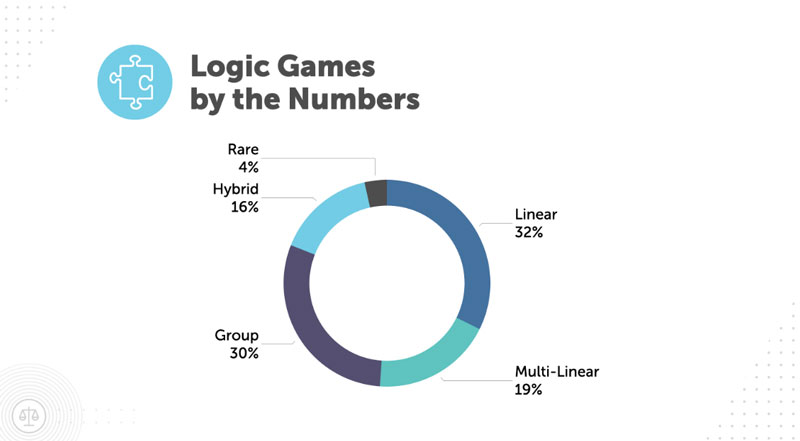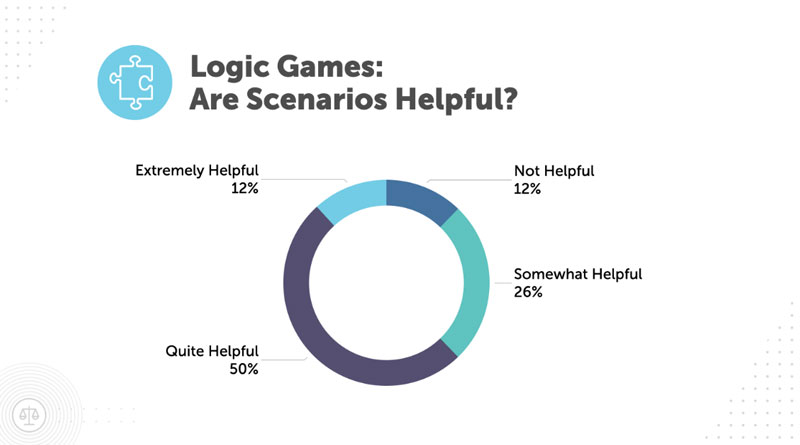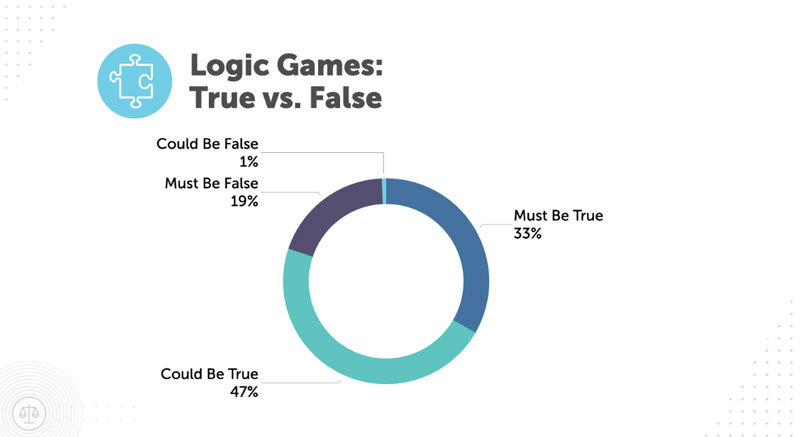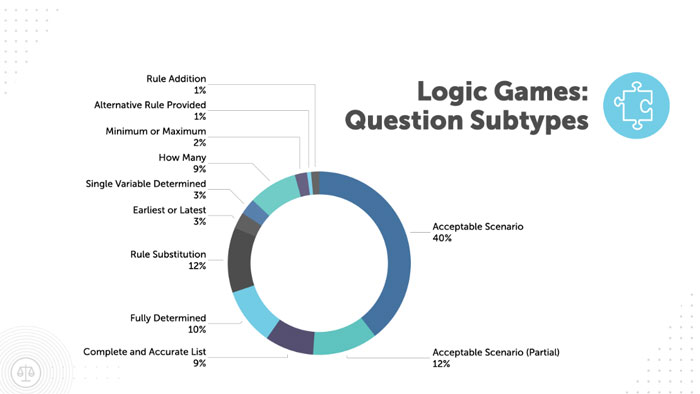Your Guide to What the LSAT Tests and How Often It Tests It
Over the last few weeks, we’ve broken down the Logical Reasoning and Reading Comp sections of the LSAT. We’ve gone over how often those sections test various concepts to give you a better idea of how to allocate your study time.
We want your study plan to reflect what’s actually going to yield you the most points. After all, no one wants to get bogged down trying to master a concept that will, at best, earn them one point when they could have spent that time developing skills that will earn them many points.
We’re very excited to end this series with the Logic Games section. Elsewhere, the data you’ll find on this section tends to be very limited. This rudimentary data might say how often the various game types show up on the LSAT, but they won’t tell you what techniques are best suited for solving those games or exactly what the questions will ask.
In an effort to remedy this, let’s dive headlong into a feast of charts and figures below.
Logic Games

We’ll start off with a breakdown of the types of games, just in case you haven’t seen this elsewhere.
About a third of all the games on the LSAT since 2015 are linear games (some call these “ordering” or “sequencing” games), which involve placing variables in a particular order. Linear games always have some kind of inherent sense of order to the slots, whether it’s the order runners finish in a race, houses arranged from East to West on a street, days of the week, or floors of a building from top to bottom.
In addition to linear games, there’s another, very similar type of game called multilinear games (some call these “tiered” games). These are just like linear games, except that there will be multiple rows of variables to work with. For instance, you might be placing delivery trucks in order, but you might need an additional row on your diagram to keep track of what color the delivery trucks are. They account for about 19% of recent games on the LSAT.
You’ll also have to learn about group games, which account for another 30% of all recent games. These games involve placing variables in groups, rather than in order. For instance, you might be asked to determine which of five colors of yarn will be used to knit three sweaters, or divide up six doctors among four clinics.
Most of these group games involve games with three or more groups (these represent about 20% of all games). 5% of games involve exactly two groups, and 5% involve forming just one group. These latter games are often known as “In/Out” games since they require test-takers to form one “In” group, leaving the remaining variables “Out.”
Of the remaining 20% of games, about 16% are hybrid games (sometimes known as “combo” games). These games combine elements of both linear and group games. For example, you might be asked to split a list of ingredients into those being used in a dish and those being left out, and then place the ingredients that are being used in the order in which the chef will add them to the cookpot.
With these stats in mind, we recommend dedicating a little more time to linear games than group games, unless you find grouping to be a much greater challenge to you (as many do). After building those skills up, move on to the hybrid games, which should function as a review of the skills you built up while studying for linear and group games.
Less than logic games 4% are what can be called “rare” games, “lost boys” games, or “neither” games. These games, as some of their monickers might suggest, do not involve the ordering or grouping of the variables. These games are also very uncommon and shouldn’t take up much of your study time. In fact, these games have been such a non-factor on recent exams that we don’t recommend addressing them until you feel like you’ve maxed out your abilities on all the games you probably will see.
Logic Games Strategies: Scenarios

Now that we have the types of games out of the way, let’s get into techniques that you can use to solve games. After crunching the numbers, we think no technique is better suited to recent games than making scenarios. Some refer to this technique as making “worlds” or “templates.”
Making scenarios involves dividing your game up into a few possible outcomes that could occur based on how the rules limit the variables. Each possible outcome is called a “scenario” (or “world” or “template.”) Usually, you try to limit the number of scenarios to four or fewer. Then, before answering any of the questions, you try to draw deductions in each scenario.
For instance, suppose we were solving a linear game in which six runners finish from first place to sixth place. If we learned that Aaron must finish the race exactly two places ahead of Charlie, then there are only four possible outcomes for that game: (1) Aaron first and Charlie third; (2) Aaron second and Charlie fourth; (3) Aaron third and Charlie fifth; and (4) Aaron fourth and Charlie sixth. In this game, we could write out four versions of the game based on those four outcomes and figure out what else would happen in each outcome. (For far more information on scenarios, check out this webinar.)
The benefits of scenarios are at least three-fold. One, scenarios force us to build helpful visual aids. Many test-takers have trouble imagining how the rules and variables interact. Scenarios externalize that internal process — they require us to write out how the game will proceed. They allow us to think with our pencils, which makes figuring out how the rules and variables interact much easier.
Second, scenarios boost our understanding of the game and, thus, build our confidence. Each scenario starts with a limiting factor. This makes it easier to make more inferences about how the game will work itself out. If we already know where two of the six runners will place, it will be much easier to make deductions about the remaining four runners. With that added knowledge, we’ll better understand how the rules and variables interact. On more complex and difficult games, scenarios become an even more important tool to ensure we have an adequate understanding. And with that understanding, we’ll feel much more confident as we answer the questions — no more second guessing or analyzing more answer choices than necessary!
Finally, scenarios save us time when answering the questions. Scenarios allow us to front-load much of the work answering questions. If we did a good job making the scenarios, many of the answers will already be embedded in our scenarios. Instead of grinding through each question, we only need to consult our scenarios. Many questions ask about the same scenario. So, rather than having to do the same work twice, we can consult the same scenario for both questions and avoid duplicating our work.
Not all games are well-suited to this strategy. There are many games in which no limiting factors help us make scenarios. There are some games in which the scenarios we could make would only waste our time. But, as you can see in the above graph, scenarios are at least somewhat helpful on the vast majority of recent games. Only 12% of recent games are games for which we can’t make any reasonable case for scenarios.
On 26% percent of recent games, scenarios are somewhat helpful. There are rules or limitations that we can use to make scenarios. Although these scenarios are not the only viable way to understand how the rules and variables interact, they can help you reach that understanding.
For half of the recent games, scenarios are quite helpful. They are the best way to visualize the game, develop a command of the rules and variables, and work through the questions efficiently. While some test-takers might find other means to work through these games, most test-takers would consider scenarios the best solution. And on 12% of the games, scenarios are extremely helpful — it would be extremely difficult to work through the game without scenarios.
Given this, it’s crucial that every test-taker dedicate time to learning how to make scenarios. And not only learning how to make scenarios but getting lots of practice — even doing games more than once — to experiment with how to make scenarios with different kinds of rules and limiting factors. You should also spend time determining how many scenarios you are willing to make. (Most test-takers set four as the maximum number of scenarios they’re willing to make. However, test-takers who work more quickly may be willing to make five or six under the right circumstances, while more deliberate workers might set a max of three scenarios.)
Logic Games Questions
In addition to dedicating time to learning strategies to solving the game, it’s important we also spend time figuring out which kinds of questions challenge us or slow us down. Even the best-made scenarios won’t help us if we don’t have an efficient process for answering certain types of questions. And, the more frequently a specific type of question appears on the LSAT, the more time we should dedicate to it.
In this area, we’re willing to share much more information than you might find elsewhere. Many other curricula will only tell you about the relative frequency between global/“absolute”/“Which” questions and local/“conditional” /“If.” But such a reductive breakdown would be like trying to approach Logical Reasoning only knowing the difference between questions that ask about arguments and questions that ask about sets of facts. There’s far more nuance to explore in a study process.
So our breakdown will provide far more detail on what the questions ask. Two questions might both be “global,” but if one question simply asks what could be true and the other asks how many distinct orders of the variables are possible, our approach to answering that question might be very different. So, we hope this breakdown will give you an idea of what things the test-makers like to ask about, so you can dedicate appropriate study time to developing approaches for the various questions.

“Global” questions (also known as “absolute” questions, which almost always begin with “Which”) do not add any information for us to consider. Answering them requires us to look at only the original rules and variables. On the other hand, “local” questions (also known as “conditional” questions, which almost always begin with “If”) will add a new rule to consider. That rule only applies to that question, and we have to determine what could or could not happen if that rule was added to the original set of rules. As you can see from the above graph, the test-makers ask a roughly equal number of global and local questions — meaning we need an equally good approach to both.

If we assess how the questions are framed — as in, are the test-makers asking you to select an answer choice that must be true, could be true, must be false, or could be false — we might be able to see why the logic games section presents a challenge.
The plurality of questions asks what could be true. If you do not figure out how the rules and variables interact, most or all of the answer choices will seem like they could be true. Answering these questions will be difficult and will likely require a lot of trial and error as you experiment with various answer choices and see whether they could be true.
However, if you’ve figured out how the rules and variables interact — perhaps with a good set of scenarios — you’ll have a much better idea of what can’t happen in the game’s various outcomes. That will help you quickly identify what could be true.
Figuring out how these rules interact, by the way, will also allow you to determine certainties in the game, helping you on the 33% of the questions that ask you to identify what must be true and the 19% that ask you to identify what must be false.

In this chart, we’re digging a little deeper into the types of questions that will sometimes appear on games. Most questions will ask us simply to identify what “could be true,” “must be true,” etc. But, sometimes, we’ll get questions that ask us something more specific. Such questions are represented above.
Here’s a quick glossary of these question subtypes:
Acceptable Scenario
Correct answer: A complete arrangement of the variables that does not violate any of the rules
Example question stem: “Which one of the following could be the schedule for the conference?”
Acceptable Scenario (Partial)
Correct answer: An incomplete arrangement of the variables that does not violate any of the rules
Example question stem: “Which one of the following could be the list of the middle five accomplices, in the order in which they were recruited, from second to sixth?”
Complete and Accurate List
Correct answer: An exhaustive list of all the variables that could go in a specific place in the setup, or all of the places in the setup in which a specific variable could go
Example question stem: “If Londi sits immediately next to Manley, then which one of the following is a complete and accurate list of representatives any one of whom could also sit immediately next to Londi?”
Fully Determined
Correct answer: The answer choice that, if added to the original rules, would result in only one possible arrangement of all the variables
Example question stem: “The schedule for the publication of the cookbooks is fully determined if which one of the following is true?”
Rule Substitution
Correct answer: The answer choice that, if substituted for one of the original rules, has the exact same effect on the variables as the original rules
Example question stem: “Which one of the following, if substituted for the condition that Lewis and Ota do not lecture on the same day as each other, would have the same effect in determining the schedule for the conference?”
Earliest or Latest
Correct answer: The earliest or latest position that a variable could go without violating any of the rules in a linear game
Example question stem: “Of the following, which one is the latest year in which James could have joined the firm?”
Single Variable Determined
Correct answer: The answer choice that, if added to the original rules, would result in only one possible outcome for a specific variable
Example question stem: “Molly must be assigned to 1922 if which one of the following is true?”
How Many
Correct answer: The answer choice that identifies the exact number of variables that could go in a specific place in the setup or the exact number of places in the setup in which a specific variable could go
Example question stem: “How many of the students are there who could be the one assigned to 1921?”
Minimum or Maximum
Correct answer: The minimum or maximum number of variables that can precede or follow a specific variable (in a linear game) or variables that can join a specific group (in a group game)
Example question stem: “What is the minimum number of groups that must be evaluated after the teachers?”
Alternative Rule Provided
Correct answer: Will depend; these questions will change one of the original rules and will ask what could/must be true/false
Example question stem: “Suppose the condition that only Zepi uses exactly one hyacinth and exactly one rose is replaced with the condition that Zepi and at least one other person use exactly one hyacinth and exactly one rose. If all the other initial conditions hold as given …”
Rule Addition
Correct answer: Will depend; these questions will add one rule to the original rules (usually a more general limitation than those added on local questions) and will ask what could/must be true/false
Example question stem: “Suppose that the computer in office 2 and the computer in office 3 had been bought in the same year as each other. If all of the other conditions remained the same, then which one of the following machines could have been bought in 1989?”
The most common question subtype, by far, is the Acceptable Scenario question. In fact, these are typically the first question in a Logic Game. That’s great news for most test-takers since these questions are relatively straightforward. We recommend doing these questions by process of elimination. Go through the rules, and eliminate each answer choice that violates one of those rules until you’re left with one remaining.
After that, the most common question subtypes are Acceptable Scenario (Partial), Fully Determined, and Rule Substitution questions. Test-takers find these questions much less straightforward than the regular Acceptable Scenario questions. However, most find these questions are simplified with scenarios — further emphasizing the importance of that technique.
Interestingly, a few of the least common question subtypes — Earliest or Latest, Alternative Rule Provided, and Rule Addition — mostly appeared on the “experimental” sections of PT91 and PT92. Unlike normal experimental sections, these were probably not actual experimental sections LSAC administered. Rather, they are old, unreleased sections that LSAC added so PTs 91 and 92 mimic the current format of the LSAT. The appearance of these question subtypes in these experimental sections is not surprising since these questions were far more common on older tests than they are now. If we remove these “experimental” sections from the data, these question types have essentially vanished from recent Logic Games sections. At any rate, honing your approach to these questions should not take up much study time.
This data also reveals that Complete and Accurate List and How Many questions are quite common. Many test prep services do not even discuss these as distinct question subtypes. Make sure to find an approach that works for you when answering these questions.
— — — — —
And that will conclude our breakdown of the Logical Reasoning, Reading Comprehension, and Logic Games sections. We hope you’ve found this data informative and helpful. Now that you’re empowered with this information, it’s time to get to work allocating yoru study time to the material that will yield you the most points.
If you’d like to learn about LSATMax’s approach to Logic Games, sign up for a free LSATMax account.









